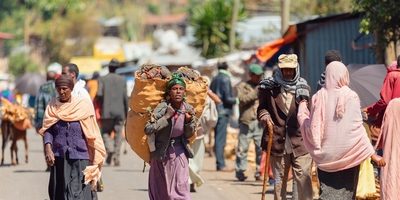
COVID-19 is putting health systems around the world under the microscope – what are we learning?
Authored by Professor David Peiris and Professor Stephen Jan
In this week that we mark World Health Day, the focus on world health is unprecedented. As a research organisation, the obvious question to ask is where the research community should be best focusing our efforts. Clearly, the COVID 19 epidemic crisis has highlighted the need to develop vaccines, quicker tests and new ways of treating the disease; and there is a great deal of well-documented progress being made on these fronts. But when such breakthroughs come, we will need to deliver them rapidly at scale, prioritising those populations that need them most. This means having, amongst other things, well-functioning supply chains, good governance, adequately trained personnel, robust health information systems and the right financing models – the basic building blocks of a health system. Any health systems pandemic planning and response must also consider how COVID-19 can exacerbate existing inequities.
In Australia, the pandemic is highlighting many of the country’s strengths – a strong public health, primary health care and hospital system with a well-trained and dedicated health workforce. But it is also exposing weaknesses. Our siloed funding models that are driven primarily by fee-for-service models of care make coordinating the governments’ response across primary and hospital care, private and public sectors hugely challenging.
We’ve seen inefficiency in cross jurisdictional (state/federal/interagency) decision-making as was the case with the Ruby Princess cruise ship disembarkation and the resulting blame game between different agencies and levels of government. We’ve also seen both challenges and opportunities that have arisen from this crisis in supporting GPs to conduct virtual consultations. In a matter of weeks we have had to address a problematic billing system, where reforms have been debated and rejected for over a decade. We now have rebates for virtual consultations for GPs and other providers, but they still rely on fee-for-service transactions. These are not fit for purpose when taking a population health approach. Shifting to virtual consultations also raises questions about how well-placed GPs are to conduct these consultations from home (if self-isolating), have remote clinic access to the patient’s EMR, generate prescriptions or test request forms remotely and process the billing, etc. Those GPs that have made substantial infrastructure investments will be better prepared for this than others.
By contrast, a population health approach is being taken by the state governments with walk-in fever clinics, drive by testing, fastidious contact tracing and a wider range of workforce personnel being deployed, which makes a lot more sense and does not depend on fee-for-service transactions. Even in a time where state/federal coordination is better than ever, our legacy systems leave us exposed to fragmented responses. One of the authors (DP) recently had two patients present to clinic who were assessed to be at high risk for COVID-19 and should have been tested, but they later ended up at the public hospital fever clinic and did not get the same advice. Pleasingly there is now clearer direction on testing when GPs consider a patient to be at risk.
There are lessons we can also learn from places overseas with more experience in having to address severe staffing and resource constraints. Some are arguing that well-resourced countries like the UK should be adopting the community health worker* models that many low- and middle-income countries have successfully done for decades. Colleagues who have worked effectively with community health workforces in India and across the African region are quick to outline the benefits and applicability of this approach. Some governments are already investigating the role community health workers can play in COVID-19 prevention and control. In the last couple of weeks the National Health Systems Resource Centre India commissioned a report to inform the development of plans and resources to ensure preparedness of frontline health workers (accredited social health activist or ASHA) for COVID-19.
While Australia has decades-long experience demonstrating how successful Aboriginal Health Practitioners have been in providing culturally safe, coordinated and comprehensive care, it’s time we recognised that this model of excellence could be applied for all Australians. It would bolster the health system, making us more resilient in times of crisis, and support high quality, accessible, equitable care into the future. As governments grapple with the strain on health care professionals to treat COVID-19 patients, and look at strategies such as fast-tracking medical students or returning retired workers to the workforce, they should also be looking at building and supporting a community health workforce in partnership with general practice and other primary care providers to boost frontline capacity.
These are tangible reasons for international health systems collaboration - harnessing the opportunities to learn from, support and work better with our neighbours – but to also examine what is already working effectively in pockets of our own back yard.
Even in the midst of such an immediate public health emergency it is worth noting that the different approaches countries are taking reflect how culture, politics and community values critically influence the way health systems are funded and operate.
Health systems research can and should unpack these lessons to strengthen how we, as a global public health community, respond not only to the ongoing demands of COVID 19 and future pandemics, but also to the enduring, but silent pandemics of chronic diseases.
COVID 19 is highlighting how our health and wellbeing is intrinsically tied to that of the rest of the world. The case for wealthy countries such as Australia to support the Sustainable Development Goals and invest in both its own health system and support those of its neighbours is now stronger than ever.
*Community health workers should be members of the communities where they work, should be selected by the communities, should be answerable to the communities for their activities, should be supported by the health system but not necessarily a part of its organization, and have shorter training than professional workers. Source: World Health Organization.
About the authors
Professor David Peiris (MBBS(hons) MIPH PhD FRACGP FARGP) is Director of the Global Primary Health Care Program (Better Care) and Co-Director of the Centre for Health Systems Science. He is a Professor in the Faculty of Medicine, UNSW Sydney and works clinically as a GP in Sydney.
Professor Stephen Jan (PhD FAHMS) is Head of the Health Economics and Process Evaluation Program and Co-Director, Health System Science at the George Institute for Global Health and Conjoint Professor at the University of New South Wales.



